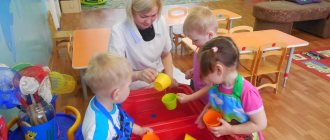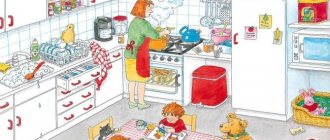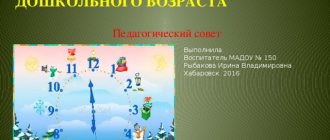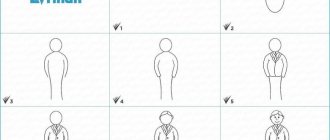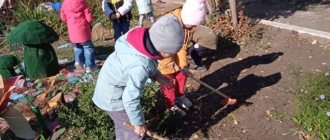MAGAZINE Preschooler.RF
Children's and adults' long-term project "Russian Izba".Karnaukhova Lyudmila Yuryevna MBDOU "DSKV No. 102" teacher Irkutsk region, Bratsk
Introduction to the project.
Russia is our Motherland. To consider yourself her son or daughter, you need to feel the spiritual life of your people, accept the Russian language, history and culture as your own. The essential content of Russian culture is folk art and everyday life, created over the course of centuries of history.
Type of project: Introductory and indicative.
Project participants: Children of middle preschool age, parents, teachers.
Implementation period: 1 year.
Project goal: Formation of ideas about Russian peasant life, respect for Russian folk culture.
Project objectives:
- Introduce children to the structure of a Russian hut;
- Introduce the variety of household items, their names and purposes;
- Introduce the traditions of the Russian people;
- Introduce Russian folk costume and folk instruments;
- Introduce the new word “amulet” , develop children’s skills in making amulet;
- Expand vocabulary: hut, roof, log house, crown, tub, cradle, spinning wheel, bench, chest;
- Study of small folklore forms (fairy tales, songs, nursery rhymes, proverbs);
- Introduction to Russian folk round dance games;
- Make a model of a Russian hut;
- Arouse positive emotions and interest in Russian folk culture;
- Foster love and respect for the history of your people.
Relevance of the project.
The first years of a child’s life are an important stage in his upbringing. During this period, those feelings and character traits begin to develop that can invisibly connect him with his people, with his country and largely determine the subsequent path of life. The roots of this influence are in the language of his people, in his songs, impressions of the nature of his native land, work, life, morals and customs of the people among whom he lives. From early childhood, a child needs images, sounds, colors - all this is carried in abundance by the life of the Russian people. Introducing children to the origins of folk culture has not lost its importance even today.
The novelty of the “Russian Izba” .
Compliance of the project with the principles stated in the Federal State Educational Standard - the principle of integration of educational areas. Also, the main thread in the project is directly working with parents.
In this project, you can trace the connection between educational areas:
Artistic and aesthetic development
Communicative and personal development
Cognitive development
Speech development
Physical development
The project is built on a complex thematic principle: creating a model of the mini-museum “Russian Izba” in accordance with the themes of the week.
Subject of study.
Russian hut with its internal contents (dishes, furniture, toys, musical instruments, Russian costume, etc.)
Problem. When reading a Russian folk tale based on “The Pike’s Command,” children had questions: What is a Russian stove? What is a hut? Who lived in such a house? Why do you need a stove in the house? What kind of clothes did people wear? What songs did you sing, what fairy tales did you listen to? Therefore, I considered it necessary to convey to the children’s consciousness the history of Russian life, the structure of a village hut, and the variety of ancient household items.
Hypothesis.
Through a native song, a fairy tale, mastering the language of his people and its customs, a preschool child will receive his first ideas about the culture of the Russian people. Objects of national life will awaken curiosity and a sense of beauty in the child’s soul, which will allow him to feel like a part of the Russian people.
Hypothesis testing. Research methods.
- Excursions to the mini-museum.
- Conversations with children.
- Looking at illustrations on the theme of life in the village.
- Reading fiction.
- Productive activity (making a talisman)
- Theatrical games.
- Examination of household items and utensils.
- Learning nursery rhymes, jokes, nicknames.
- Use of Russian folk songs and dances.
- Holding Russian folk games.
- The use of Russian folk costumes in holidays and independent activities.
- Acting out scenes and episodes from fairy tales.
- A story about folk customs and traditions.
Stage I – preparatory.
Goal: develop a project.
| Next > |
Integrated lesson in the preparatory group of a preschool educational institution on the topic “Journey through a peasant hut”
- February 7, 2017
International and All-Russian competitions
All-Russian competition of pedagogical excellence “Methodological piggy bank of a kindergarten teacher”
Integrated lesson in a preparatory group.
Topic: “Journey through a peasant hut”
Goal: study the life of the Russian people, develop interest in the past, in the origins and customs of the Russian family.
Tasks:
- Educational: to introduce students to the origins of Russian folk culture; summarize existing knowledge about the small homeland; enrich children's vocabulary ("Red Corner", "Babiy Kut", rubel); expand and systematize knowledge about the traditional everyday culture of the Russian people (hut: its interior decoration; special places in a Russian hut).
- Developmental: develop children's curiosity, observation, speech, fine motor skills; the ability to perform simple dance exercises to musical accompaniment and perform familiar songs.
- Educational: nurturing love and respect for the origins of Russian folk culture , pride in one’s people, the Fatherland; goodwill towards peers; desire to learn new things.
Integration of areas : “Social and communicative development”, “Cognitive development”, “Speech development”, “Artistic and aesthetic development”, “Physical development”.
Type of lesson: lesson - formation and improvement of knowledge.
Lesson form : virtual excursion
Methods: verbal, cognitive, game.
Preliminary work: excursion to the local history museum and the mini-museum “Russian Izba”, research work on the study of folk costume, reading fairy tales, artistic expression (poems about the Motherland, riddles, proverbs, nursery rhymes, fables).
Equipment: multimedia complex, elements of Russian folk costume, peasant household items.
Demonstration material: electronic presentation “Journey through a peasant hut”
Handouts: photographs of the sights of Pavlovsk, paired pictures of household items of the past and present, mnemonic cards on the topic “Oven”, salt dough, decorative decorations.
Progress of the lesson
I. _ Organizing time:
Hostess: Hello, invited guests, welcome guests!
We welcome our dear guests with a lush, round loaf. It is on a painted platter, With a snow-white towel. We offer you a loaf of bread, We bow and ask you to taste it.
(Children break off a small piece of bread, dip it in salt and eat).
Mistress:
From all doors, From all gates, hurry up, get ready for the round dance.
(Music sounds, against its background the child reads a poem about the Motherland).
Child:
In the wide open space, in the pre-dawn time, scarlet dawns rose over the native land. Dear lands become more and more beautiful every year. There is nothing better than our Motherland, friends!
Hostess: Guys, what is the poem talking about?
Children: About the Motherland.
Hostess: What is the name of our Motherland?
Children: Russia!
Hostess: Every person on earth has a small homeland. How do you understand what “small Motherland” is?
Game "Pass the Flag".
Hostess: I suggest passing the flag and saying what you think the small Motherland is.
- 1 child M.R. is the place where we were born and live.
- 2 reb. M.R. is the land on which our grandfathers and grandmothers live and work.
- 3 children M.R. is a place where people close and dear to us live: moms and dads.
- 4 children M.R. is the place where our kindergarten is located.
- 5 reb. M.R. is a place that people miss when they are in a distant land, on a foreign side.
- 6 children M.R. is our city of Pavlovsk.
II. Updating knowledge:
Hostess: That's right, our big country is Russia. In this big country there is a place where we were born and live - this is our small Motherland. I propose to tell you a little about my small homeland, about Pavlovsk. I will start, and you show the photo and finish....
- In this place the lions sit, looking in all directions. They protect the gentle sleep and the peace of Tsar Peter. (Petrovsky Square).
The ribbon in the open space trembles a little in the breeze, The narrow tip is in the spring, And the wide one is in the sea. (Don River)
Whether during the day, at night, early in the morning, If something catches fire, then a reliable team quickly rushes to help. Remember firmly, friends, that you CANNOT joke with fire! (Fire Department)
The guide told us how to get to such and such a hall. We looked at all the utensils, and saw what we were wearing. Even a mammoth lies here, its eyes closed, as if sleeping. If you are not a mouthful, then go quickly to... (museum).
This house is not just a house. He is beautiful and has a cross. Golden domes. Ringing bells. (Church)
There is a cheerful, bright house. There are a lot of agile guys there. There they write and count, draw and read. (School № 1).
There you can watch cartoons, magazines, clips, films. We go there as a whole group. It’s good there, and it’s cozy there! We haven’t been there for a long time, it’s time to visit... (Rodina cinema)
Green meadow, A hundred benches around From gate to gate People are running briskly. At the gates of these Fishing Nets... (Yunost Stadium).
There are a lot of toys, as well as children, this Teremok is called... (Kindergarten).
There is never a dull moment in this house. They sing, dance, and guests come. And you went to perform - Russian dances (Contemporary).
(Children sit on chairs in a semicircle in front of the board).
III . Message of topic, goals and objectives:
Hostess: But people didn’t always live like this. And it’s not for nothing that you and I are wearing such clothes - this is a Russian folk costume, and you are kind fellows and beautiful girls. I suggest you take a trip into the past and see how people lived in the old days, what kind of homes they had, how and how they arranged their life.
“Let’s sit side by side and talk well”.
(Children sit on chairs in a semicircle in front of the screen.)
Slide 1. We will take a trip through the Russian hut, they called it “The Upper Room”. And now, you are welcome to our hut.
IV . Introduction of new material
Slide 2.
Hostess: The main one in “Gorenka” is “Red Corner”. Why do you think it's "red"? (children's answers)
Hostess: The red corner in a Russian hut means beautiful, main. The cleanest, brightest, most elegant place in the entire peasant house. The icons are located here. Right there in the corner there was a long oak table, at which the dear guest was seated. They were greeted not with flattery, but with honor. They treated the guest to the best dishes that the hosts had, saying: “Pies and porridge are our food.”
Riddle: Arina stands opposite, her long mouth open. In winter she eats everything and screams, but in summer she sleeps hungry! Guess what? (Bake). Well, of course, our fat stove.
Slide 3
The whole way of life, the whole life of a peasant, is connected with the stove. The oven was made of brick and coated with clay on top. What do you think, what was the name of the person who laid the stove (children's answers). That's right, a person who knew how to lay a stove - a stove maker - enjoyed honor and respect. The fame of a good stove maker spread throughout the area. It was important not just to fold the stove: it had to hold heat for as long as possible, and require as little firewood as possible.
The stove not only heated the hut, it was multifunctional. What else do you think people used the stove for, these pictures will help you (children's answers).
The Russian people have always been famous for their hospitality, but what sayings do you know about the stove and the hut?
- What is in the oven is all on the table - swords.
- If you want to eat rolls, don’t sit on the stove.
It was not for nothing that the people endowed the stove with magical properties, and the image of the stove became traditional for Russian fairy tales. Guys, remember in which fairy tales you heard about the stove? (children's answers).
Slide 4. (she hides Masha and her brother from the evil swan geese, takes Emelya to the king, etc.)
Slide 5
Hostess: But the yoke is hanging on a nail, and the brownie, Kuzka, bends down and plays with it. The brownie also moved to the new hut along with the people (showing the brownie) - he was transported in a worn bast shoe, into which earth was poured from under the stove of the old house.
In the darkest corner behind the wall, under a chimney, there lived a good-natured and naughty brownie. He regularly kept order around, protected the House from evil as a devoted friend. And comfort and warmth reigned in that house. Everyone who lived in it was invariably lucky.
(A child is heard crying.)
Hostess: Oh, who's crying there? (Children's answers)
Slide 6.
The baby is lying in a crib - called a cradle. They hung it on a hook hammered into the ceiling. How can I calm him down? (sing a lullaby). What lullabies did your mothers sing to you (children’s answers). Let's sing "Bay-bayushki-bayu!"
Slide 7-8.
The mother put her baby to bed, and she herself baked and cooked, spun and sewed for the whole large family. And she had a place for this between the stove and the wall of the house, which was called “woman’s kut” or kutok - this is a corner that was separated from the rest of the hut by a colored curtain. She had assistant tools that the brownie hides behind the stove.
Slide 9
Puzzles:
He drags porridge out of the Russian oven, rolls. The cast iron is very glad that he was grabbed...(grab).
Hostess: Next to the stove there is a matchmaker - an evil one with a horned grip! He grabs everything from the oven and quickly puts it on the table. Oh, what kind of dump is this? Yes, this is our... (spinning wheel)! Her name is Nastasyushka - a needlewoman. She spins threads from animal wool, and uses the threads to knit blouses, socks and mittens. During the day he sleeps, rests, and as soon as evening comes, he spins with a torch and gives work to the women.
Mistress:
Irons dresses and shirts, tightens our pockets. He is a faithful friend in the household - His name is... (iron).
But Pavlukha’s irons do not spare their belly, they still iron and iron the linen.
Guys, here are the irons with coals. The coals were placed inside the housing and covered with a lid. (Show iron). The first Russian iron doesn’t even look like an iron. Look! (Show ruble). The wet fabric was wrapped around a roller and a corrugated board called a ruble was passed over it. This is how the linen turned out to be ironed, but without folds or wrinkles.
Slide 10
Hostess: Living quarters were traditionally illuminated by a torch. What do you think it's made of? (Children's answers). Candles were rarely used, usually in wealthy families or on holidays during prayer.
Slide 11
Hostess: There is a chest near the wall, puffed up like a turkey. Clothes for the whole family were stored there. Russian costumes were festive and everyday (for every day). I would like to note that any costume, women's or men's, festive or everyday, must have a headdress.
Slide 12
Hostess: So we lived and did not grieve. They baked pies, cooked porridge, and chopped wood with an axe. They washed clothes in the river and raked hay in the meadow. On weekdays they worked without straightening their backs, but on holidays they danced and sang songs, so loudly and sonorously that no one was bored. I showed you what was in our “Russian Upper Room”. Now let's walk together and tell us what we saw there?
V. Physical exercise
I walk around the upper room and tell you what I see. (let’s go, hands on the belt) There’s a stove on the right, a table on the left (we wave right and left) We rest against the floor (tilt) The door is straight (bow) Above it is a horseshoe (on toes, hands up) So that the family is healthy.
And our brownie now wants to ask whether antique objects are found in our time, or maybe they have changed, but the essence remains the same?
VI . Didactic game "Find a pair"
Housewife : Our brownie has already taught us a lot, but he was not the only one who protected the hut; besides him, there were other amulets that protected a person’s home. Maybe you know what was hung above the front door? (Children's answers)
VII. Practical work.
Hostess: In the old days, people thought about how to protect their home from the evil eye and attract wealth and happiness into the house; it was for this purpose that in the old days it was customary to hang a horseshoe “for luck” above the front door, always with the horns up, so the horseshoe resembles cup and so that happiness, prosperity, luck do not flow out of the house. I suggest that you, dear guests, make a horseshoe-amulet that you can hang in your home for good luck!
Slide 13
Hostess: Come to the oak tables and sit on the wide benches!
(Salt dough modeling and horseshoe decoration).
VIII. Game "Tangle"
(A brownie appears with a basket and balls).
Housewife: Our brownie is such a naughty boy that he played with balls, but not simple ones, on each ball there are a bunch of proverbs, but the red one fell out of the basket and the proverbs about work unraveled, we need to wind it up and collect the proverbs.
- You can’t even pull a fish out of a pond without difficulty.
- Patience and work will grind everything down.
- Who does not work shall not eat.
- The eyes are afraid, but the hands are doing.
- Finished the job - go for a walk safely.
- Time for business, time for fun.
Hostess: “There is time for business, but there is an hour for fun . After all, in Rus' they knew how to not only work, but also relax - sing songs and dance.
Girls dance to the song “The Moon is Shining”, boys play instruments.
The moon is shining, the moon is shining, the moon is shining, an old man has come to visit you, the children from the kindergarten. You have learned everything about the hut. Our hospitable people, Like a native proverb And now living among us Round dances with a lullaby And chastushka enthusiasm, A saying and a riddle - This is all Russian folklore. The moon is shining, the light is clear. The bright moon is shining. You sang and danced. It’s time for us to part!
IX . Summarizing.
Mistress:
- Where did we go on an excursion today? (children's answers)
- What antique objects did you come across? (children's answers)
- Who defended the house? (children's answers)
- What else is a talisman for the home? (children's answers)
Hostess: Dear guys! Love your Motherland, big and small, take care of its nature, preserve traditions and customs!
